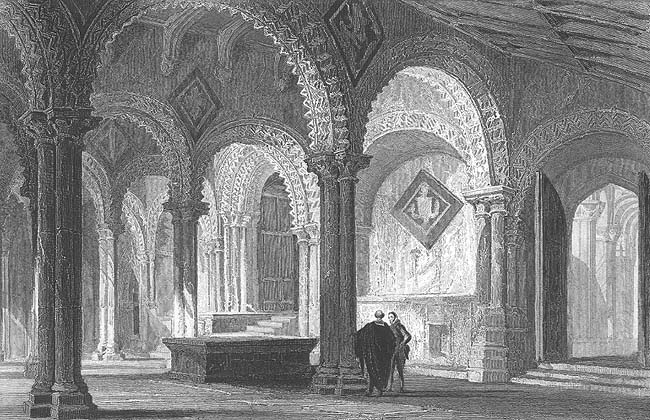
St. Cuthbert, the patron saint of the cathedral church at Durham, conceived a great antipathy to females' and forbade them to approach his shrine, in consequence of an unjust charge brought against him, whilst pursuing a solitary life in the country of the Picts, by a daughter of the king of the province. When the followers of the saint had transferred his " incorruptible remains' to Durham, and raised an ecclesiastical structure to his especial honour, they perpetuated the prejudices of their patron by strictly forbidding women to enter the holy sanctuary. In consequence, a structure, named the Galilee, was appended to the west entrance of the building, whither females might repair to their devotions, without incurring the displeasure of the saint. The following anecdote will suffice to show how rigidly the prohibition of females to enter the church was enforced. " In the year 1333, Edward III. arrived at Durham, and lodged in the Priory, a few days after, Queen Philippa came from Knaresborough to meet him, and, being unacquainted with. the custom of this church, went though the abbey gates to the priory, and, after supping with the king, retired to rest; at which the monks were much alarmed, and one of them went to the king, and told him that St. Cuthbert had a mortal aversion to the presence of a woman. The king, unwilling to give any offence to the church, immediately ordered his queen to arise, who, in her under garments only, returned by the gate through which she had entered, and went to the castle, after most devoutly praying that St. Cuthbert would not avenge a fault which she had through ignorance committed, Hugh Pudsey, patriarch of Jerusalem, when he came to be advanced to the prelacy at Durham, considered that his predecessors, in their zeal to do honour to their patron saint, had entirely overlooked the claims of the Virgin Mary to respect and homage; he, there- fore, commenced the erection of a chapel at the east end of the cathedral, intending to dedicate it especially to her, and to give females free access for their devotional exercises. The work had not, however, proceeded far, when vast clefts were discovered in the building, which appeared to threaten an early demolition. This manifestation, as it was deemed, of the saint's displeasure, determined the bishop to relinquish his purpose. He, not withstanding, appropriated a portion of the west end, without the interior door of the church, for the Virgin's Chapel, which he named The Galilee; and into this sanctuary females were admitted without offence, but they were on no consideration to be received within the Cathedral. When the privilege of sanctuary was attached to the church of Durham, those who sought refuge were permitted to enter no farther into the building than the Galilee south door. " Certain men lay in two chambers over the north door, to answer the calls of those who fled hither, that, whenever any offenders came and knocked, they instantly let them in at any hour of the night; and ran quickly to the Galilee bell, and tolled it, that whosoever heard it might know that some one had taken sanctuary. The original entrance to the Galilee was from a small yard adjoining the church-yard, but is now by two doors from the end of the side-aisles of the nave. It is eighty feet in length by fifty in breadth, and is divided into five aisles by four rows of clustered columns with semicircular arches. The singular combination of the Norman and pointed styles of architecture displayed in the building, arose from the repairs, directed by Bishop, subsequently Cardinal, Langley, about the year 1406. The north aisle, which is now walled up, was used as a Register Office, and appropriated to the reception of wills and deeds until 1822, when amore suitable building for the purpose was erected on the west side of the Palace Green. Here were formerly three altars, now entirely removed: of these the central one was dedicated to the Holy Virgin. Close beside it is the tomb of Cardinal Langley; and in the adjoining aisle is a large marble stone, covering the remains of the Venerable Bede, the most learned man of his time. The southern side of the chapel is now divided by stalls and benches, and used as the consistory court of the diocese. BIOGRAPHY OF ARTIST: Thomas Allom (1804-1872) was born in London, England on 13th March 1804. He was articled to Francis Goodwin, an architect in 1819. He was to become a founder member of the R.I.B.A. (Royal Institute of British Architects - which is still the premier institution today). He is best know for his topographical drawings, so many of which were engraved on steel & appeared in many of the travel books of the time. He travelled extensively, not just in the UK & Europe, but further afield, covering such countries as Turkey & China. Collections of his work can be found in the British Museum and the Victoria & Albert Museum.
We pack properly to protect your item! Please note: the terms used in our auctions for engraving, heliogravure, lithograph, print, plate, photogravure etc. are ALL prints on paper, NOT blocks of steel or wood. "ENGRAVINGS", the term commonly used for these paper prints, were the most common method in the 1700s and 1800s for illustrating old books, and these paper prints or "engravings" were inserted into the book with a tissue guard frontis, usually on much thicker quality rag stock paper, although many were also printed and issued as loose stand alone prints. So this auction is for an antique paper print(s), probably from an old book, of very high quality and usually on very thick rag stock paper.
| |